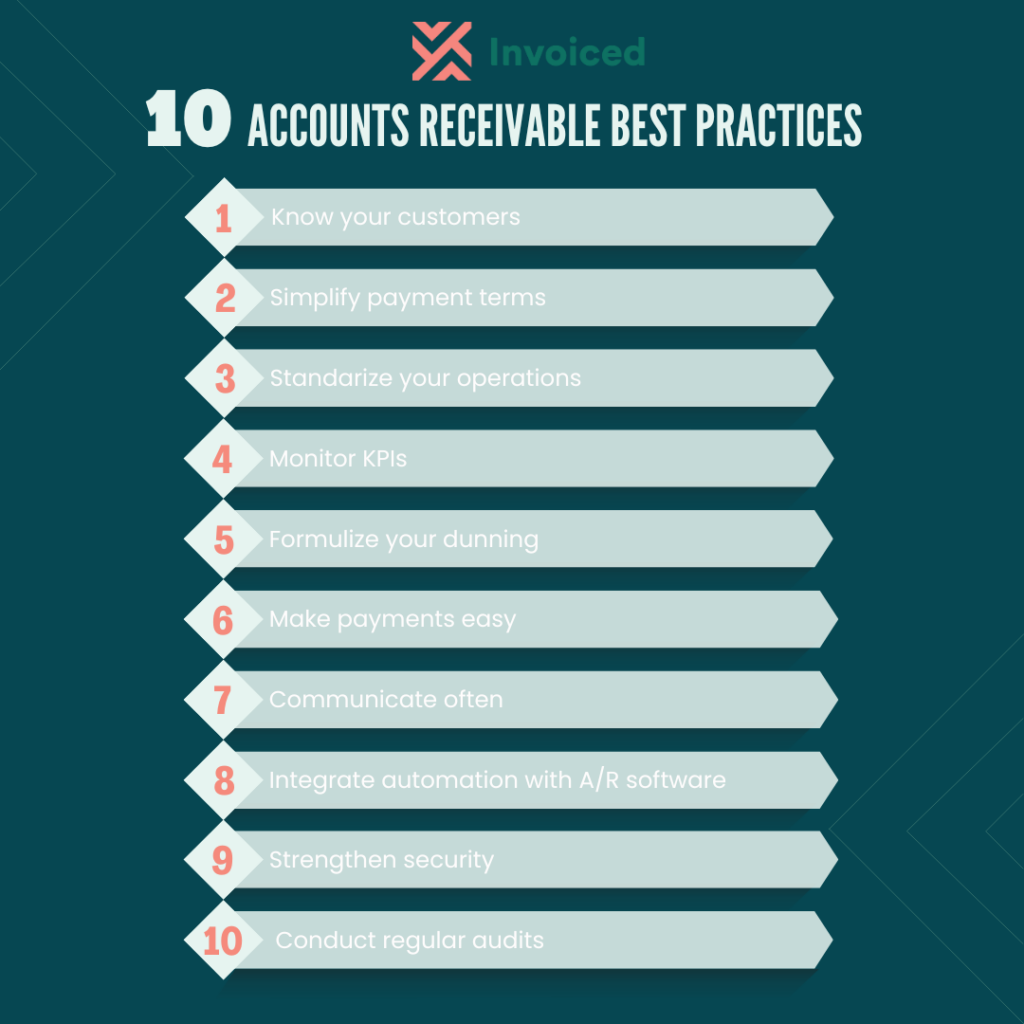When it comes to managing accounts receivable (A/R), having efficient processes in place is crucial to converting your sales successes into actual revenue. Inefficient accounts receivable systems can lead to slow payments, tying up cash and hindering your ability to seize new opportunities or pursue growth initiatives. Additionally, the longer it takes for a buyer to pay after receiving an invoice, the higher the risk of bad debt.
Effective accounts receivable management demands constant oversight and strategic investment of attention and resources. However, simply throwing money or labor at the problem is not the best solution. In this article, we will explore accounts receivable best practices and provide actionable insights to optimize your billing and collection efforts. By following these AR best practices, you can improve cash flow, reduce bad debt, and enhance overall financial health.
What is accounts receivable management?
Accounts receivable management is focused on streamlining and managing the logistics, technology, and processes tied to your invoicing, dunning, and related accounting activities. They might cover customer communications, key performance indicator (KPI) benchmarks, forecasting and budgeting, or workflow refinement. Proper and attentive management of these critical tasks directly impacts your cash flow by accelerating the payment cycle and reducing the risk of accruing bad debt.
To help you optimize your accounts receivable system, we’ve compiled a list of the top 10 best practices. By implementing these strategies, you can ensure more efficient operations and healthier financial performance.
10 best practices for accounts receivable

1. Know your customers
This practice might be less critical if your company deals with high-volume, low-cost transactions. However, if your average invoice amounts to tens or hundreds of thousands of dollars, proactively vetting every purchase is essential to minimize risk exposure.
Review their credit history for new customers and explore any publicly available financial records or reports. Are they profitable? Do they have sufficient cash flow to settle accounts, or are they heavily reliant on outside investment to stay afloat? If bankruptcy is on the horizon for them, prompt payment is unlikely for you. You can still sell to these customers but consider requiring a partial deposit upfront or cash on delivery rather than extending credit.
Even well-established buyers with a positive relationship with your organization should be regularly evaluated, although they may require a different level of scrutiny. Additionally, they routinely confirm their billing and payment details to avoid disruptions caused by changes in billing addresses or card numbers.
2. Simplify your payment terms
Your customers should never be confused about what is expected of them at every stage in the process — from the initial purchase order to the final invoice. Structure your credit and payment terms to communicate when and how payments should be made. Document these terms on every communication related to a purchase to ensure there is no ambiguity.
3. Standardize your operations
While variety might be the spice of life, it creates headaches in accounts receivable management. Each process exception or abnormality unnecessarily ties up resources and brainpower, undermining your overall efficiency and performance. Strive to handle every invoice and transaction consistently, delivering a uniform billing experience across purchases, locations, and buyers.
This approach minimizes the training and oversight needed to keep your invoices moving. It organizes all funds owed to you within a common framework, reducing the likelihood that an individual payment will slip through the cracks.
4. Monitor the right key performance indicators (KPIs)
Whatever policies or processes you have in place are meaningless if they aren’t being followed. Compliance alone doesn’t guarantee success; poorly thought out or mismanaged operations can quickly eat away at your bottom line — especially if you’re unaware of the damage they are causing.
However, by monitoring certain accounts receivable KPIs, you can ensure that you understand the realities on the ground and can readily identify and diagnose process inefficiencies or other disruptions. Among other things, you should actively track your:
- Accounts receivable turnover (ART): This measures how many times your business collects its average accounts receivable during a given period, with a higher score indicating shorter collection timelines.
- Average days delinquent (ADD): This compares the actual number of days it takes your business to receive payments against the idealized timeframe, highlighting delays.
- Collections effectiveness index (CEI): This measures the percentage of your total accounts receivable that you capture over a set timeframe, making it easier to track how much of your potential income is being written off as bad debt.
- Days sales outstanding (DSO): This identifies the average time between sending an invoice and receiving payment.
Capturing these metrics is only the first step. Compile them into regular reports to gain a comprehensive, historical view of what is and isn’t working. When you know where the operational bottlenecks are, you can address and eliminate them more quickly.
| AR KPIs | Formula |
| Accounts Receivable Turnover (ART) | Net Credit Sales ÷ Average Accounts Receivable |
| Average Days Delinquent (ADD) | Days Sales Outstanding – Best Possible Days Sales Outstanding |
| Collections Effectiveness Index (CEI) | (Beginning A/R + Monthly Credit Sales – Total Ending A/R) × 100 ÷ (Beginning A/R + Monthly Credit Sales – Current Ending A/R) |
| Days Sales Outstanding (DSO) | (Accounts Receivable ÷ Total Credit Sales) × Number of Days |
5. Formalize your dunning
Only some processes will have as direct an impact on your revenue as your collections efforts. The quicker and more consistently you contact your buyers regarding their open invoices, the more likely you will receive a response. It’s beneficial to open lines of communication well before a given account misses its scheduled due date, offering reminders shortly before the deadline to encourage prompt action.
These reminders should follow an established cadence that keeps the required payment at the forefront of your customer’s mind without becoming a nuisance. Additionally, employing a multi-channel strategy — sending messages via phone, email, and text — can help prevent a potential breakdown in any single line of communication.
6. Make payments easy
No one likes to pay bills, but if this process becomes confusing or a hassle, you risk damaging existing relationships and driving customers to seek alternatives. A survey conducted by Balance Payments Inc. revealed that around 90% of respondents said a complicated buying process would have a strong negative impact on their brand loyalty. In comparison, 83% stated that a smooth payment experience was a top priority when selecting an online supplier.
To avoid these issues, focus on making the payment process convenient for your customers. Consider setting up a user-friendly payment portal that allows customers to review and pay outstanding invoices directly. Additionally, broaden the range of payment options you accept. While most businesses use credit cards or checking accounts, offering alternatives like wire transfers or Automated Clearing House (ACH) transactions can accommodate different customer preferences
7. Communicate early and often
Errors or discrepancies on invoices can prevent customers from making payments, often leading to missed due dates before you’re even aware of the issue. To avoid these problems from affecting your timelines or cash flow, offer buyers the opportunity to address any challenges or questions regarding their account statements proactively.
Proactively monitoring and addressing these issues can significantly impact your revenue. A joint study by PYMNTS and FlexPay found that businesses actively tracking failed payments lost 37% less revenue to bad debt than their peers and ultimately collected 43% more from these failed transactions.
Additionally, outdated account details frequently cause payment failures. By maintaining regular communication with your customers, you can ensure that any changes in their business are accurately reflected in your records. These interactions also provide insight into your customers’ health, allowing you to discuss alternate payment strategies if they’re experiencing financial difficulties.
8. Integrate automation with A/R software
Automation is a powerful tool for optimizing performance, accelerating payment timelines, and strengthening cash flow when managing your accounts receivable. Using accounts receivable software, you can centralize workflows to eliminate unnecessary wait times, moving invoices and payments seamlessly through your processes with minimal human intervention. Integrating your A/R software with your back-office enterprise resource planning (ERP) system allows you to pull sales and customer data directly into your invoices, reducing errors and delays associated with manual transcription.
Moreover, by automating repetitive and mundane A/R tasks, you free up your accounting staff to focus on more strategic activities, such as resolving disputes and nurturing customer relationships.
9. Strengthen your security
Fraud and cybercrime are unfortunate realities that every business must deal with. Since your A/R processes focus on collecting and handling money, these efforts will prove an attractive target to criminals. To protect your revenue, you should prioritize building a sound data security and anti-fraud strategy.
Invest in security software to limit the exposure of the private customer data stored in your records. A data breach disrupts operations and can damage the business relationships you’ve worked hard to build.
Additionally, structure your A/R workflows with validation checkpoints to ensure the accuracy and reasonableness of invoices. Restrict access to sensitive systems and process steps to only essential staff members to enhance security.
10. Conduct regular A/R audits
Regularly auditing your accounts receivable processes helps ensure that your policies and procedures are followed correctly and can reveal any discrepancies or inefficiencies. These audits can help you:
- Identify and correct errors: Discover and address errors or anomalies in billing and collections processes before they become significant issues.
- Assess policy effectiveness: Evaluate whether current policies are effective or need adjustment based on recent performance and industry changes.
- Ensure compliance: Verify that all procedures comply with relevant regulations and standards, reducing the risk of legal issues.
By incorporating regular A/R audits into your practices, you can maintain financial accuracy, improve process efficiency, and enhance overall financial health.
Revolutionize your A/R management with Invoiced
Implementing A/R best practices can significantly impact your business, but if you’re looking for the fastest way to boost efficiency and improve your bottom line, prioritizing automation is key. Of course, not all platforms offer the same level of intuitive features and consistent performance as our Accounts Receivable Automation software.
Our platform revolutionizes A/R processes with cutting-edge automation that accelerates your payment cycle and simplifies complex invoicing. With features like Smart Chasing technology, you can streamline your dunning efforts with minimal human intervention. Additionally, our self-service payment portal empowers customers to review invoices quickly, update payment details, dispute charges, and make payments — all in one place.
If you’re ready to eliminate the headaches of A/R management, schedule a demo with us today.




